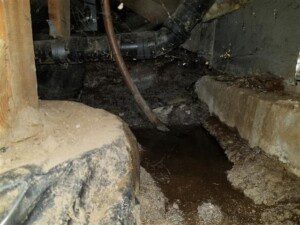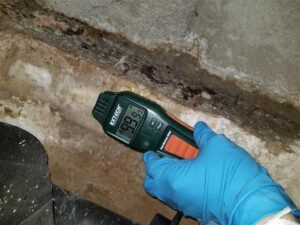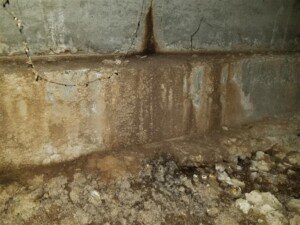Many homes built in North America have crawlspace or basement foundations. A crawlspace is a small space below the lower floor for a home, usually 3 or more feet high, that is used for routing building components such as plumbing, electrical and HVAC equipment/ductwork. The crawlspace also allows access to under the building’s subfloor and insulation. A basement is a space below the home that can usually be entered into by a person, without having to crawl.
Ideally, a crawlspace or basement should be free from unwanted water and humidity, but this is not always the case. Since these spaces are usually below the exterior grade, water intrusion issues are prevalent in many homes with crawlspaces or basements. This article will focus on some of the main causes of water intrusion into spaces below the home, which for the sake of simplicity will be referred to as a crawlspace.
- Groundwater intrusion:

- Improper exterior grading around the foundation of the home:
When the ground around the foundation has a negative or neutral slope towards the home, rain water could drain up against the foundation wall, and eventually ends up in the crawlspace. Improper grading is a very common issue, and usually requires re-grading of the ground at the exterior, or installation of low point drainage systems, such as dry wells, French drains, and sometimes installation of mechanical pumps such as sump pumps to resolve the water intrusion issues.
- Downspouts draining close to the foundation wall:

- Water leakage through foundation vents that are at or below grade:
Most crawlspace foundations have foundation vents to allow proper airflow through the crawlspace. Any foundation vent that is at or below grade is vulnerable to water intrusion issues, since water can drain through them and directly into the crawlspace. You can fix this by installing foundation vent wells around the vents to prevent water intrusion into the crawlspace.
- Water leakage or seepage through foundation cracks:

- Plumbing leaks:
Another cause of water buildup in a crawlspace is water supply and drain pipe leaks. When a home has aged plumbing, or plumbing that was not properly installed, water leaks are more likely.
Homeowners should check their crawlspace for water buildup once or twice per year, especially during the rainy season, or if there is a significant change in water usage (water bill increases significantly). Also, musty moldy smells in thye home could indicate water intrusion issues.
Check out the video below for more information about water intrusion into a crawlspace:
